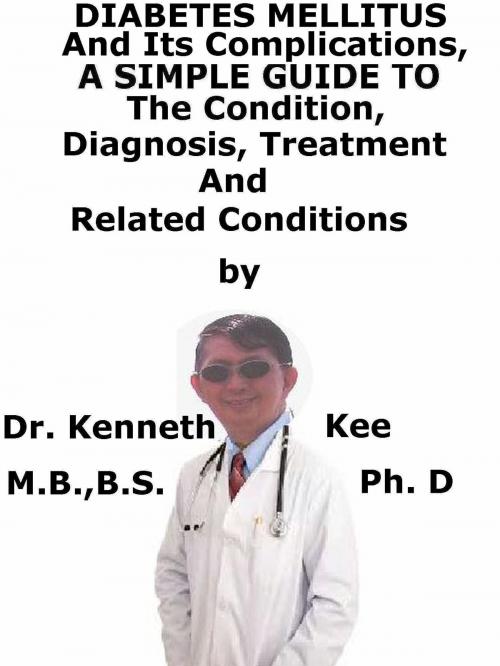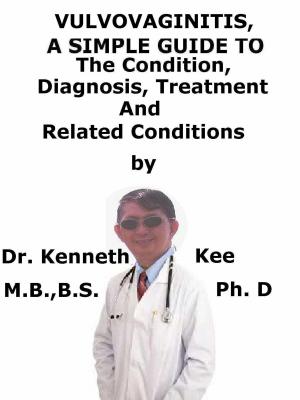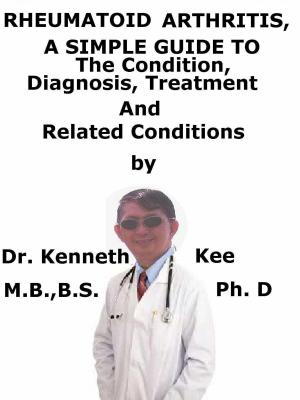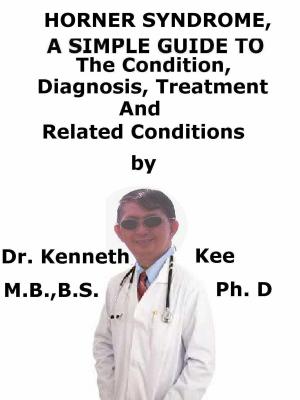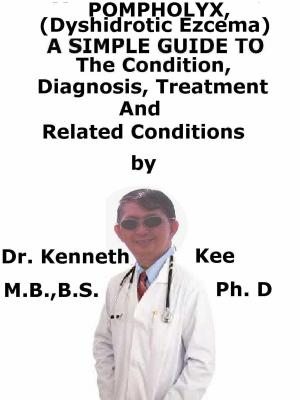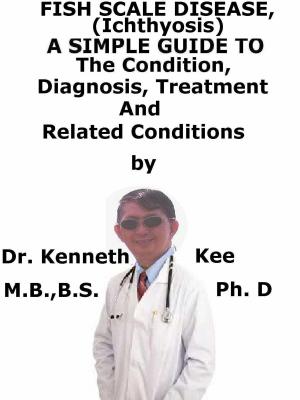Diabetes Mellitus And Its Complications, A Simple Guide To The Condition, Diagnosis, Treatment And Related Conditions
Nonfiction, Health & Well Being, Medical, Specialties, Internal Medicine, Endocrinology & Metabolism, Health, Ailments & Diseases, Diabetes| Author: | Kenneth Kee | ISBN: | 9781370170579 |
| Publisher: | Kenneth Kee | Publication: | October 12, 2017 |
| Imprint: | Smashwords Edition | Language: | English |
| Author: | Kenneth Kee |
| ISBN: | 9781370170579 |
| Publisher: | Kenneth Kee |
| Publication: | October 12, 2017 |
| Imprint: | Smashwords Edition |
| Language: | English |
Diabetes mellitus literally means sweet urine.
It is a common chronic disease which happens when the hormone insulin produced by the pancreas is missing, lacking or not working well.
Insulin unlocks the cell to allow glucose from the bloodstream to enter the body cells for usage or storage.
When this mechanism fail, the high amount of glucose in the blood leads to the glucose being spilt over into the urine, causing diabetes.
Diabetes mellitus is a nutritional disorder, characterized by an abnormally elevated level of blood glucose and by the excretion of the excess glucose in the urine.
It results from an absolute or relative lack of insulin which leads to abnormalities in carbohydrate metabolism as well as in the metabolism of protein and fat.
Its incidence is much higher at present than ever in the past.
This is especially true in case of the advanced countries of the world due to widespread affluence and generous food supply.
The most frequent screening tests are the determination of the fasting blood glucose level and the two-hour postprandial that is after a meal.
The normal fasting blood sugar content is 80 to 120 mg. per 100 ml. of blood and this can go up to a level of 180 mg. per 100 ml. of blood two hours after meals.
Anything above these norms can be termed diabetic levels.
Diabetes occurs in all age groups, from young infants to the elderly.
The greatest incidence occurs in middle or older aged persons.
The main types of diabetes are
Type 1 occurs often in children and young adults although it may occur at any age.
It is more serious because there is practically no insulin produced due to damaged pancreatic cells and therefore insulin injections is needed for treatment.
The cause is not known.
It is now believed that Diabetes mellitus is an autoimmune disease that affects the islets cells of the pancreas.
Complications are more sudden and life-threatening.
Type 2 is more common.
It is found in
1. Adults over 40 years old,
2. Overweight and
3. Physically inactive.
The insulin produced is not enough or may not be working effectively.
Type 2 diabetes can be controlled by proper dieting and exercise.
Most Type 2 diabetics will also need oral medication.
Diabetes is more likely to occur if the patient has:
1. Obesity (body mass index > 23)
2. Family history of diabetes
3. Hypertension (>140/90 mmHg)
4. Previous gestational diabetes
5. Coronary heart disease
6. Polycystic ovary disease
7. Hyper-lipidemia (high blood cholesterol >5.2 mmol or 220mg/dl and tryglycerides >2.30)
8. Inadequate regular exercise
9. Age above 40 years, more common in males than females
10. Smoking habit
The following symptoms are typical of diabetes:
1. Frequent thirst even after drinking lots of water
2. Passing more frequent urine during day and night
3. Weight loss while having good appetite
4. Constant tiredness
5. Poor healing of skin wounds
6. Itchy skin particularly around the genital area
7. Constant hunger
8. Blurred vision
Diagnosis
1. Random blood glucose (anytime) is 11.1mmol/l or higher
2. Fasting blood glucose (after 8 hours of overnight fast) is 7.0mmol/l or higher.
3. Oral 75g Glucose Tolerance Test show presence of diabetes
4. Glycosylated Hemoglobin HbA1c
Complications:
The high blood glucose concentration in diabetes reduces the blood flow to many organs and nerves resulting in much organ damage especially the:
1. Kidney (Diabetic Nephropathy),
2. Heart (Hypertension and Impotence),
3. Brain (Diabetic Coma),
4. Eyes (Diabetic Neuropathy) and
5. Nerves (Diabetic Retinopathy).
Treatment:
Oral Medicines
Insulins
Healthy Lifestyle
TABLE OF CONTENT
Introduction
Chapter 1 Diabetes Mellitus
Chapter 2 Diagnosis and Treatment
Chapter 3 Diabetes Retinopathy
Chapter 4 Diabetes Neuropathy
Chapter 5 Diabetes Nephropathy
Chapter 6 Diabetes Wounds
Chapter 7 Diabetes Impotence (Erection Dysfunction)
Chapter 8 Diabetes Coma
Epilogue
Diabetes mellitus literally means sweet urine.
It is a common chronic disease which happens when the hormone insulin produced by the pancreas is missing, lacking or not working well.
Insulin unlocks the cell to allow glucose from the bloodstream to enter the body cells for usage or storage.
When this mechanism fail, the high amount of glucose in the blood leads to the glucose being spilt over into the urine, causing diabetes.
Diabetes mellitus is a nutritional disorder, characterized by an abnormally elevated level of blood glucose and by the excretion of the excess glucose in the urine.
It results from an absolute or relative lack of insulin which leads to abnormalities in carbohydrate metabolism as well as in the metabolism of protein and fat.
Its incidence is much higher at present than ever in the past.
This is especially true in case of the advanced countries of the world due to widespread affluence and generous food supply.
The most frequent screening tests are the determination of the fasting blood glucose level and the two-hour postprandial that is after a meal.
The normal fasting blood sugar content is 80 to 120 mg. per 100 ml. of blood and this can go up to a level of 180 mg. per 100 ml. of blood two hours after meals.
Anything above these norms can be termed diabetic levels.
Diabetes occurs in all age groups, from young infants to the elderly.
The greatest incidence occurs in middle or older aged persons.
The main types of diabetes are
Type 1 occurs often in children and young adults although it may occur at any age.
It is more serious because there is practically no insulin produced due to damaged pancreatic cells and therefore insulin injections is needed for treatment.
The cause is not known.
It is now believed that Diabetes mellitus is an autoimmune disease that affects the islets cells of the pancreas.
Complications are more sudden and life-threatening.
Type 2 is more common.
It is found in
1. Adults over 40 years old,
2. Overweight and
3. Physically inactive.
The insulin produced is not enough or may not be working effectively.
Type 2 diabetes can be controlled by proper dieting and exercise.
Most Type 2 diabetics will also need oral medication.
Diabetes is more likely to occur if the patient has:
1. Obesity (body mass index > 23)
2. Family history of diabetes
3. Hypertension (>140/90 mmHg)
4. Previous gestational diabetes
5. Coronary heart disease
6. Polycystic ovary disease
7. Hyper-lipidemia (high blood cholesterol >5.2 mmol or 220mg/dl and tryglycerides >2.30)
8. Inadequate regular exercise
9. Age above 40 years, more common in males than females
10. Smoking habit
The following symptoms are typical of diabetes:
1. Frequent thirst even after drinking lots of water
2. Passing more frequent urine during day and night
3. Weight loss while having good appetite
4. Constant tiredness
5. Poor healing of skin wounds
6. Itchy skin particularly around the genital area
7. Constant hunger
8. Blurred vision
Diagnosis
1. Random blood glucose (anytime) is 11.1mmol/l or higher
2. Fasting blood glucose (after 8 hours of overnight fast) is 7.0mmol/l or higher.
3. Oral 75g Glucose Tolerance Test show presence of diabetes
4. Glycosylated Hemoglobin HbA1c
Complications:
The high blood glucose concentration in diabetes reduces the blood flow to many organs and nerves resulting in much organ damage especially the:
1. Kidney (Diabetic Nephropathy),
2. Heart (Hypertension and Impotence),
3. Brain (Diabetic Coma),
4. Eyes (Diabetic Neuropathy) and
5. Nerves (Diabetic Retinopathy).
Treatment:
Oral Medicines
Insulins
Healthy Lifestyle
TABLE OF CONTENT
Introduction
Chapter 1 Diabetes Mellitus
Chapter 2 Diagnosis and Treatment
Chapter 3 Diabetes Retinopathy
Chapter 4 Diabetes Neuropathy
Chapter 5 Diabetes Nephropathy
Chapter 6 Diabetes Wounds
Chapter 7 Diabetes Impotence (Erection Dysfunction)
Chapter 8 Diabetes Coma
Epilogue
